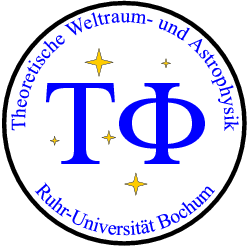Strömgren sphere
The photons from a star with energies higher than the ionization energy (13.6 eV) of an hydrogen atom can ionize the latter. The ionization will be balanced by the recombination between protons (H+) and electrons. The region were all hydrogen atoms are ionized is called the "Strömgren sphere". Its radius can be estimtaed by balancing the recombination and ionisation rate. The Strömgren radius \(R_{S}\) is given by:\begin{eqnarray} R_S = \left(\frac{3}{4\pi} \frac{Q_\star}{n^{2}_{H} \beta_{2}(T)} \right)^{(1/3)} \end{eqnarray}
where \(Q_\star\) is total number of photons per second with frequencies \(\nu_{1} \ge 13.6 / h\) (where \(h \approx 6.626\cdot 10^{-34}\) [J s] is the Planck constant), \(n_{H} [cm^{-3}]\) the hydrogen number density, and \(\beta_{2}(T) [cm^{3}s^{-1}]\) the total volume recombination rate.
We only take the recombination into the second energy level, because when recombining to the ground state (first energy level) a photon with the same energy is released and ionizes again. The total volume recombination rate can be approximated by
\begin{eqnarray} \beta_{2}(T) \approx 2.06\cdot 10^{-11} Z^2 T_{e}^{-0.8} = 1.29\cdot 10^{-14} Z^2 T_{e,4}^{-0.8} = 8.20\cdot 10^{-14} Z^2 T_{e,3}^{-0.8}[cm^{3} s^{-1}] \end{eqnarray} where \(Z\) is the atomic number (\(Z=1\) for hydrogen) and \(T_{e,4}=10 T_{e,3}\) is the electron temperature measured in units of \(10^{4}\) or \(10^{3}\) K, respectively (Spitzer 1968).
The total number of emitted photons (\(\ge \nu_{1}\)) of a star can be calculated with the help of radiation transfer theory (Hubeny & Mihalas 2014): At a frequency \(\nu\) the intensity is denoted by \(I_{\nu}\), the energy density by \(J_{\nu}\), and the Planckfunction by \(B_{\nu}\). For a homogeneous raditioan field the following holds \begin{eqnarray} I_{\nu} = J_{\nu} = B_{\nu} = \frac{2 h \nu^{3}}{c^{2}}\ \dfrac{1}{e^{\frac{h\nu}{k T}} - 1} \end{eqnarray} The specific luminosity can be expressed with \(J_{\nu}\) as \begin{eqnarray} L_{\nu} = 4 \pi^{2} r^{2}J_{\nu} \end{eqnarray} from which we get the number of photons with frequency \(\nu\) as \(L_{\nu}/(h\nu)\) and the total number of ionizing photons is then \begin{eqnarray} Q_{\star}=\int\limits^{\infty}_{\nu_{1}} \frac{L_{\nu}}{h \nu} d\nu = \frac{8\pi^{2} r^{2}}{c^{2}} \int\limits^{\infty}_{\nu_{1}} \dfrac{\nu^{2}}{e^{\frac{h\nu}{k T}} - 1} d\nu \end{eqnarray} Replacing \(\nu\) by \(x = \frac{h\nu}{kT}\), gives \begin{eqnarray} \frac{8\pi^{2} r^{2}}{c^{2}}\ \left(\frac{k T}{h} \right)^{3} \int\limits^{\infty}_{x_{1}}\frac{x^2}{e^{x}-1} dx \end{eqnarray} The lower boundary \(x_{1}\) of the integral depends only on the temperature and for \(h\nu_{1}=13.6\,\)eV and the Boltzmann constant \(k\approx 8.617\cdot 10^{-5}\,\)[eV/K] we have \begin{eqnarray} x_{1}=\frac{h\nu_{1}}{k T} = \frac{13.6}{8.617\cdot 10^{-2}} = \frac{1.57 \cdot 10^{2}}{T_{3}} \end{eqnarray} Thus for a solar type star with \(T_{3} = 5.78\) we get \(x_{1}=27.3\) and for a hot star with \(T_3 = 50\) it follows \(x_{1} = 3.14\). Therefore, the lower boundary of the integral is clearly greater than 0, and thus the denominator of the integral can be approximated by \(e^{-x}\), which then allows to solve the integral. \begin{eqnarray} \int\limits^{\infty}_{x_{1}}\frac{x^2}{e^{x}-1} dx \approx \int\limits^{\infty}_{x_{1}} x^2 e^{-x} dx = \left. -(x^{2} + 2 x +2) e^{-x} \right|^{\infty}_{x_{1}} \end{eqnarray} Collecting all the factors, leads for the total photon rate \(Q_{\star}\) to \begin{eqnarray} Q_{\star} &=& \frac{8 \pi^{2} r^2}{c^{2}} \left(\frac{k T}{h} \right)^{3} \left(\frac{h^{2}\nu^{2}_{1}}{k^{2}T^{2}} + 2 \frac{h \nu_{1}}{k T} + 2 \right) e^{-\dfrac{h\nu}{k T}}\\ %&=& \frac{8\pi^2\cdot 6.96^{2}\cdot 10^{20} r^{2}_{\odot}}{2.99^{2}\cdot 1%0^{20}} %\ \left(\frac{1.38\cdot 10^{-16}}{6.63 \cdot 10^{-27}} \right)^3 \cdot 1%0^{9} T_{3}^{3} \\ %&&\cdot \left(1.57^{2}\cdot 10^4 T_{3}^{-2} + 1.57\cdot 10^{2} T_{3}^{-1} + %2 \right) e^{-1.57\cdot 10^2 T_{3}^{-1}}\\ \ &=& 3.85\cdot 10^{41} r_{\odot}^{2} \left(2.46\cdot 10^4 T_{3} + 1.57\cdot 10^{2} T_{3}^{2} + 2 T_{3}^{3} \right) e^{-1.57\cdot 10^2 T_{3}^{-1}} \end{eqnarray} where \(r_{\odot}\) is the radius of the star given in solar radii. Inserting \(T_{3}=5.78\) for the Sun and \(T_{3} = 50, r_{\odot}=20\) for a hot star, we get \begin{eqnarray} Q_{\star,\odot} = 7.92\cdot 10^{34} [s^{-1}] \qquad Q_{\star,50}= 1.25\cdot 10^{49} [s^{-1}] \end{eqnarray} To calculate the Strömgren radius the number density of the local interstellar medium (LISM) and its electron temperature is needed. The latter is usually not directly accessible, but we can assume, that the protons, the neutral hydrogen and electrons are in thermal equilibrium. For \(n_{H} = n_{e} = n = 1 [cm^{-3}]\) and \(T_{e} = T_{p} = T_{H} = 10^4 [K] = T_{4}\) we get with the above formulas (\(Z=1\)): \begin{eqnarray} R_S &=& %\left(\frac{3}{4\pi} \frac{Q_\star}{n^{2}_{H} \beta_{2}(T)} \right)^{(1/3)} = \left(\frac{3}{4\pi} \frac{Q_\star}{n^{2}_{0} \beta_{2}(T)} \right)^{(1/3)}\\ %&=& 1.92 \cdot 10^{18} \left(2.46\cdot 10^4 T_{3} + 1.57\cdot 10^{2} T_{3}^{2} + 2 T_{3}^{3} \right)^{1/3}e^{-52.33 T^{-1}} %r_{\odot}^{2/3}n^{-2/3}_{0} T_{e.3}^{4/15}\\ \ &=& 0.62 \left(2.46\cdot 10^4 T_{3} + 1.57\cdot 10^{2} T_{3}^{2} + 2 T_{3}^{3} \right)^{1/3}e^{-52.33 T^{-1}} r_{\odot}^{2/3}n_{0}^{-2/3}T_{e.3}^{4/15} [pc] \end{eqnarray} where \(T\) is the temperature at the stellar surface and \(T_{e}\) that of the LISM and \(n_{0}\) given in \(1 cm^{-3} \). With the above numbers we get for the the Strögren radius \(R_{s,\odot}\) of the Sun (\(T_{3}=5.78, r_{\odot}=1, n_{0} = 1, T_{e,3} = 10\)) and that for the hot star (\(T_{3}= 50, r_{\odot} = 20, n_{0}=1, T_{e,3}=10\)) \begin{eqnarray} R_{s,\odot} = 0.0039 [pc] = 797 [AU] \qquad R_{s,50} = 199 [pc] \end{eqnarray} Usually the LISM number density around O stars is assumed to be \(n_{0}=1000\) and we have to multiply the above values with 0.01: \begin{eqnarray} R_{s,\odot} = 7.97 [AU] \qquad R_{s,50} = 1.99 [pc] \end{eqnarray} The LISM around the Sun has a number density \(n_{0} = 0.1\) and \(T_{e,4} = 6.75\) and the parameters for \( \lambda \) Cephei are \( T_{\lambda,3}= 34, r_{\odot} \approx 20, n_{0}=11, T_{e,4}=1\) (from wikepedia and our paper) and thus we have \begin{eqnarray} R_{s,\odot} = 3300 [AU] = 0.016 [pc] \qquad R_{s,\lambda} = 20.6 [pc] \end{eqnarray} Use the calculator below based on the above numbers for other cases
The Strömgren radius
Definition There are several limitations of the above result: The above estimate is only valid for a static Strömgren sphere (Ritzerveld 2005).A number density of \(n_{0} = 1000\) leads almost to a reversal of the solar type stellar winds into an accretion (Talbot & Newman 1977).
There is no relative motion between the star and the LISM. For the Sun Blum & Fahr (1975) showed that the neutral hydrogen can penetrate deeply into the inner solar system, Mackey et al. 2014 discussed a ionisation front for slowly moving stars. For a critical discussion see Fahr 1991.

